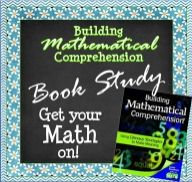
Only two more chapters to go. That just reminds me that summer is coming to an end. Bummer! But the journey to the end has been filled with a lot of interesting math info. You can find little recaps of each chapter by visiting the links below:
Chapter 8- Synthesizing Information
Students should be synthesizing during and after their reading and math work.
But what does synthesizing mean for students? It means that they take the information they know about a topic and merge it with the new information they are learning to create a completely new idea or way of thinking about that topic. (227)
What should students know about synthesizing?
1. Mathematical thinking changes as new ifnormation is encountered. It's okay to revise our previous thoughts and ideas about a topic in light of new information that we're learning. Reflection is a great way to make that happen! (231)
2. New information should be tied to prior knowledge in order to create meaning. Students need to be sure that there is consistency as they build on their prior knowledge. (231)
3. Synthesis is what you get when you combine information from various sources that you already have experience with and with various new sources of information. (231)
4. Synthesis changes as we encounter new information. (232)
5. Synthesis helps with mathematical understanding. Discussion is important in helping students see how synthesizing deepens their understanding of math concepts.(232)
Concrete Examples to Teach Synthesis
Nesting Dolls- Just like nesting dolls, larger ideas can be made up of smaller details, ideas, and concepts. All the little pieces and parts work to build the big concept. (236)
Baking a Cake- Separate ingredients are used to make a cake. Separate ideas can all contribute to one overarching concept. (236)
Conjectures
One of the most effective ways to promote rigorous thinking in students is to have them make conjectures, or educated guesses or predictions. (237)
Boy is Sammons right when she says that teachers struggle with this idea. Well, this teacher does anyways. It's much easier in my mind to teach math the "traditional" way. I teach the concept, kids practice the concept, I test if they've learned the concept.
But deeper understanding is gained when students have to do the hard work themselves to arrive at the big concept. Teaching math concepts through problem solving is key. Not my natural tendency let me tell you. Another reason I'm glad to be a part of this study. Push myself a little a guess :)
As always Sammons suggest Math Stretches as a way to implement this strategy. This time, however, she suggests taking a backward approach. Give the synthesis, have students provide the details. For example, asking students to Support or Disprove This Conjecture helps them come up with the proof. (240)
I love one thought she includes at the end of the chapter: "Students deserve the opportunity to delve more deeply into the discipline of mathematics, to become more than procedurally proficient." (246)
WOW!
Students deserve that opportunity. Far be it from me to take that opportunity away from my students! I've got some work to do when it comes to teaching math, but as always I'm up for the challenge and can't wait to get out on that limb!

No comments :
Post a Comment